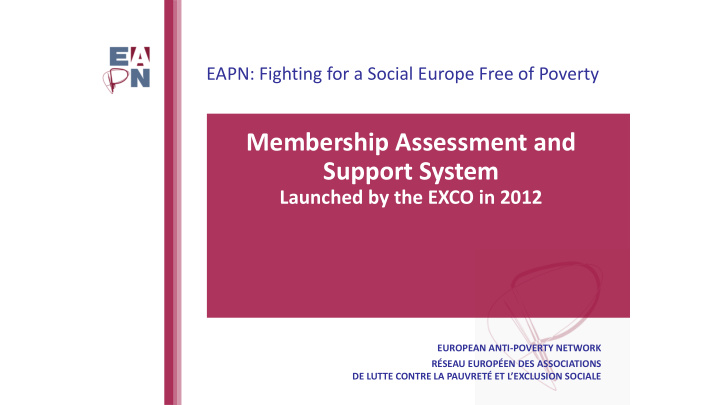



EAPN: Fighting for a Social Europe Free of Poverty Membership Assessment and Support System Launched by the EXCO in 2012 EUROPEAN ANTI-POVERTY NETWORK RÉSEAU EUROPÉEN DES ASSOCIATIONS DE LUTTE CONTRE LA PAUVRETÉ ET L’EXCLUSION SOCIALE
What the Membership Assessment and Support System is and What It Is Not A framework proposal to help National Networks grow, based on common understanding of aspirations along the four pillars of strong National Anti Poverty Networks – as indicated by the Executive and as set in the statutes A set of essential elements universally applicable to any NGO or civil society actor and one that EAPN asks of itself and of its partners – to help members work towards the same vision A peer-review Support and Accompaniment System by colleagues from other NNs A basis for development work (to be completed with support tools, templates and to highlight good practice from members) Not a punitive system Not a top-down process – horizontal, led by peers Not a tool to apply only to struggling members, but a reference framework for everyone
Four Pillars of Strong Anti Poverty Networks Influence National Governments for better policies: advocacy, lobbying and policy-making linked to European level developments Participation of People Experiencing Poverty and Social Exclusion in Internal and External Workings of the National Network Development and Growth of the Network Growth Training and capacity building Good governance and strong internal democracy Strong internal democracy Management of workers and volunteers/activists Strategic planning/thinking Funding (starting with contracts with EAPN)
Indicators and Ways to See How Those are Implemented Proposal of 3 essential indicators for each area and a way to understand how those are being fulfilled (documents, discussions, annual report) Additional recommended indicators Lists of documents that can show how the indicators are fulfilled Additional lists and examples; templates could be proposed. Highlighted the importance of annual reports which the Bureau has reinstated as a practice already for the GA 2013. From the list of documents, none of them are beyond normal NGO practice.
Implementation Process Starting with Exco decision on which NN undergoes MASS Self-reflection as a first stage and basis for the assessment process Support and Accompaniment Teams, involving two representatives from other NNs and support person from secretariat – terms of reference defined jointly with the network undergoing the MASS Peer review and capacity building visit – learning dialogues with different structures of the NN Agreement for implementing changes and follow-up Recognition in EAPN GA or other EAPN Europe space of the process the NN has engaged with.
Putting It Into Practice in EAPN Trialing and improving it (EAPN Iceland + MAPP trialled the whole process; it was used in the support visit to EAPN Romania and for induction to new members Croatia and Latvia) Making the MASS a development framework for EAPN National Networks drawing learning in the process adapting the training and capacity building agenda based on the MASS pillars and drawing on the learning that happens in process Using all tools available for the development process (ex: solidarity grants from EAPN Fund; Annual Reports of Networks and all the policy and capacity building work that happens through EAPN Europe work)
Recommend
More recommend